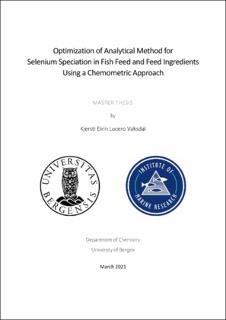| dc.description.abstract | Selenium (Se) is an essential element for humans, as well as for fish, including Atlantic salmon (Salmo salar). One of the main sources of Se and other elements for farmed salmon is the diet. Due to the replacement of marine-based ingredients with plant-based ingredients in fish feed, supplementation of Se has been considered necessary to maintain normal functions in fish. There are different chemical forms of Se, often characterized as Se species. Se species can be either inorganic or organic. Organic Se has higher a bioavailability than inorganic Se. However, inorganic Se is considered more toxic than organic Se. Other elements, such as the essential elements cobalt (Co), chromium (Cr), copper (Cu), iron (Fe), manganese (Mn), and zinc (Zn), and non-essential elements such as cadmium (Cd), mercury (Hg), lead (Pb) and arsenic (As), may also be present in salmon. Some of these elements are known to interact with Se, but few studies have investigated the effects of the Se species on the interactions between Se and other elements. In fish feed, Se can be supplemented, both in forms of inorganic Se (e.g. selenite) and as organic Se (e.g. selenomethionine (SeMet) or SeMet produced by Se-enriched yeast. Maximum limits have been established for Se as a feed additive for animals by the European Commission, set to a total of 0.5 mg Se/kg. For SeMet and SeMet produced by the Se-enriched yeast (Saccharomyces cerevisiae), the limit is set to 0.2 mg Se/kg. Due to this difference in legislation for the supplementation of Se species, there is a need for analytical methods that can discriminate between the different Se species. In this thesis, the overall aim was to apply chemometrics and other statistical approaches for handling data obtained from salmon a feeding trial with Atlantic salmon, and for the method optimization for determining Se species in fish feed and feed ingredients. This study evaluates the correlations between Se and other elements in salmon fed with feed supplemented with inorganic or organic Se species. Furthermore, the extraction procedure for an analytical method determining SeMet in fish feed and feed ingredients using was optimized using chemometric tools. The correlations of Se to other elements were assessed in whole-bodies and fillets of salmon. The samples were from a previous feeding trial (Berntssen et al., 2018b), and were analyzed by ICP-MS for determination of total Se, As, Cd, Co, Cr, Cu, Fe, Hg, Mn, Pb and Zn. To assess correlations between Se and other elements in salmon, two statistical methods, Pearson’s and Spearman’s correlation coefficients. The correlation study showed interactions between Se and Hg in whole-body and fillet samples, and Se and Cu in whole-body samples. It was also seen interactions between inorganic Se and As, and between inorganic Se and Fe in whole-body samples. Method development was further performed to optimize a Se speciation method for the determination of organic Se in fish feed and feed ingredients analyzed by HPLC-ICP-MS (Sele et al., 2018a). Different factors were tested using experimental designs: i) extraction solutions (ammonium phosphate or a mixed buffer solution, both with pH 7), ii) an enzymatic pre-extraction step (with or without papain) and iii) enzymes for main extraction (protease type XIV, protamex, α-amylase and cellulase). Principal component analysis (PCA) was performed on the SeMet recovery as a response for the certified reference materials ERM BC210a (wheat flour) and SELM-1 (selenized yeast). From the experiments, the combination of protease and cellulase (1:1 ratio) for enzymatic digestion, with ammonium phosphate, and without a pre-extraction step was seen to be the most optimal method for extraction of organic Se. The optimized method was furthermore applied to experimental diets as well as commercial fish feed and feed ingredients (i.e. fish meal, plant meal and insect meal). The method was evaluated to be more accurate for the determination of SeMet in higher concentrations in feed but did not show sufficient recovery for Se in feed and feed ingredients at lower levels. Other Se peaks were observed in the chromatograms for some fish feed and fish meal, with unknown chemical structures. From this thesis, the use of statistical and chemometric approaches was considered beneficial for assessing correlations between elements and the method development. From the correlation study, a large dataset was obtained, with many outliers. For this, visualization of data through boxplots was a useful tool for excluding the outliers. Shapiro-Wilk normality testing was also useful for determining data distributions for further assessment of Pearson’s and/or Spearman’s correlation coefficients. For method development, experimental design was useful for limiting the number of experiments, while facilitating for finding the best conditions for increasing SeMet recovery. Possible interactions between factors were also provided by using experimental design and PCA. Although more work is needed for an optimal Se speciation method, the results from this thesis show that experimental design and PCA are useful approaches also for future method development. | |
